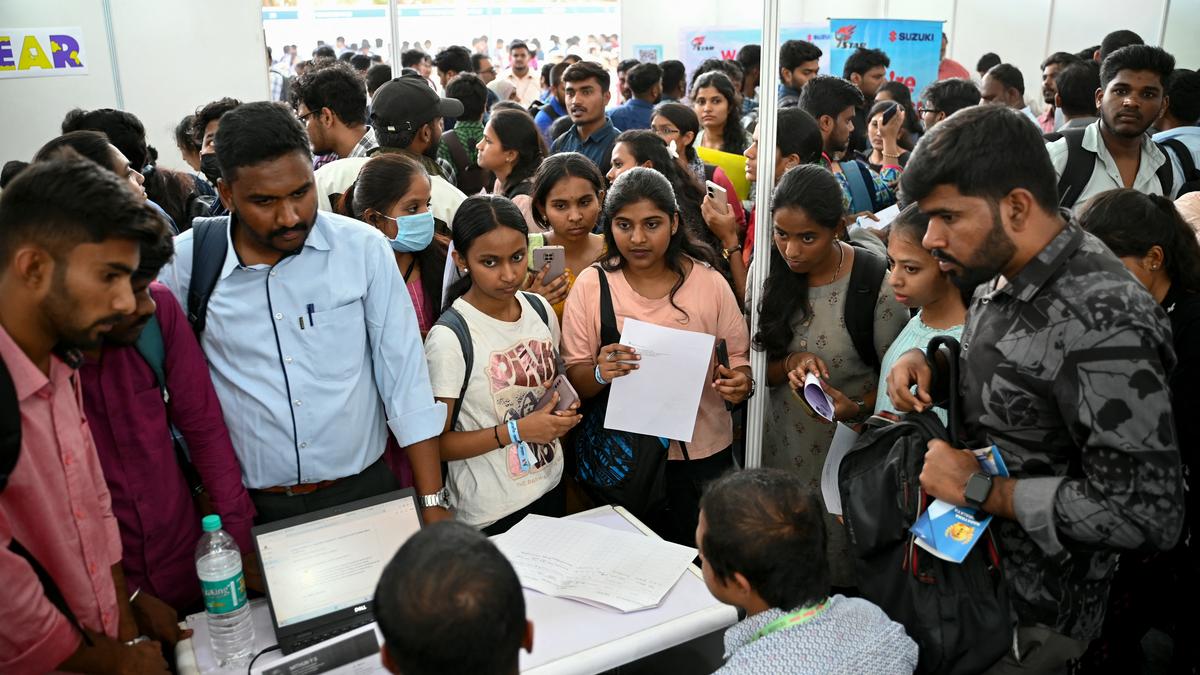
“According to the India Employment Report 2024, published by the International Labour Organization and the Institute for Human Development, the youth account for 83% of India’s unemployed population”. File
| Photo Credit: AFP
Each year, lakhs of students graduate from universities, colleges, Industrial Training Institutes, and skill programmes in India. Yet the system continues to face challenges not only in accommodating them, but also effectively integrating them into meaningful employment.
The Employees’ Provident Fund Organisation (EPFO) plays a central role in India’s social security system by managing retirement savings for workers in the organised sector. With over 7 crore members, it remains one of the world’s largest social security organisations. EPFO data serves as a valuable indicator of formal employment trends. The share decline in net new EPFO enrolments post-2019 reflected the pandemic effect on formal employment. However, the March 2025 data shows a steady increase in formal workforce participation. Young professionals, particularly fresh graduates, constitute a significant portion of new enrolments. The 18-25 age group consistently represents a large share with the 18-21 subgroup alone accounting for around 18%- 22% of the total new subscribers in the recent months. The trend signals a push towards formalisation but demands a deeper analysis of job stability, wages and long-term financial security.
Youth unemployment
According to the India Employment Report 2024, published by the International Labour Organization and the Institute for Human Development, the youth account for 83% of India’s unemployed population. Alarmingly, the share of unemployed individuals with secondary or higher education has nearly doubled over two decades.
The issue goes beyond unemployment; this is a crisis of unemployability. The Economic Survey 2023-24 states that only about half of India’s youth are deemed job-ready after graduation. One in two lacks the digital and professional skills employers’ demand, particularly in an economy undergoing rapid technological transformation. Moreover, the looming influence of AI threatens India’s tech sector, putting several traditional job roles at the risk of displacement. Without adequate reskilling and upskilling efforts, the gap between graduate output and available opportunities will only widen.
Despite economic progress, India’s workforce remains predominantly informal. The India Employment Report 2024 notes nearly 90% of employment is informal with the proportion of salaried, regular jobs declining since 2018. While contractual employment has grown, concerns about job security and social welfare remain unresolved.
Many young Indians struggle with technical skills. The report states that 75% of young people struggle with basic digital tasks such as sending an email with an attachment. Over 60% cannot perform simple file operations such as copy-pasting and 90% lack fundamental spreadsheet skills such as working with formulas.
These statistics are worrying given that the Future of Jobs Report 2025 by the World Economic Forum forecasts major shifts in employment dynamics.
The report states that by 2030, an estimated 170 million new jobs will be created representing 14% of total employment. However, 92 million existing jobs (8% of total employment) will be displaced. This means there will be a new growth of 78 million jobs, or a 7% increase in total employment. While these projections offer optimism, they also highlight the urgency of bridging the skill gap to ensure that India’s workforce is adequately prepared for the evolving job landscape.
What India must do
India stands at a critical crossroads. Without targeted policy interventions and expansive reskilling initiatives, millions of graduates will continue struggling to secure meaningful employment. Investing in education, vocational training, and digital literacy is essential for aligning the workforce with future job demands.
Urgent structural reforms are needed. First, there should be stronger collaboration between industry and academia, if necessary, by law. Each higher education institution must ideally have at least one formal partnership with industry partners. Second, educational institutions need to be held accountable for placements and not just educational degrees. We need to create accreditation systems for educational institutions aligned with job placements for the outgoing students. Idea Labs and Tinker Labs should be made mandatory components of every high school and higher education institution. The integration of the humanities, foreign language learning, and soft skills should be made mandatory across all levels of education.
Third, India needs to extend its focus beyond national borders. Skilling and training programmes should be designed to meet the needs of ageing societies in many Western nations, where the demand for young professionals is expected to increase. This approach aligns with the Indian government’s strategy for enhancing the international mobility of skilled workers. The International Institute of Migration and Development is currently working as the Indian partner in the European Union’s Link4Skills project that utilises the migration corridor framework to evaluate the skill demands and labour shortages in various European countries and beyond. Fourth, to drive these transformations, an Indian Education Services, similar in stature to the Indian Administrative Services, should be established; it would attract the best minds into the education sector. Finally, the education system should open its doors to professionals from the industry. This would help bridge the gap between theory and application.
S. Irudaya Rajan, Chair, International Institute of Migration and Development, Kerala; S.P. Mishra, Founder, India Career Centre, Hyderabad
Published – July 14, 2025 01:52 am IST
